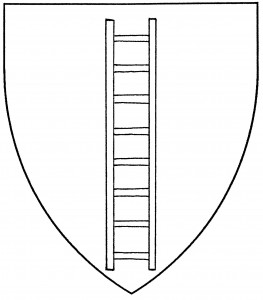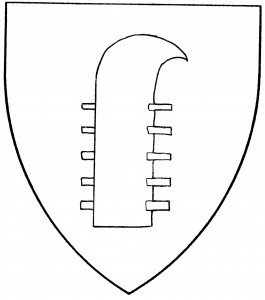A ladder is a climbing tool, with two side pieces connected by a series of rungs; the side pieces were most commonly drawn parallel, though they were frequently drawn wider at the bottom for extra stability. It is a period charge, found as early as c.1340, in the canting arms (German Leiter) of Leiterberg [Zurich 260].
A variant, the “scaling ladder”, has hooks at the top for fastening to a wall; it was used in sieges. This form is found in the arms of Shipstowe, 1610 [Guillim1 230]. (The German form of scaling ladder, illustrated, is drawn quite differently, as a broad hooked post with footholds on either side; it’s found in the arms of von Bredow or Bredaw, 1605 [Siebmacher 174]. This stylization seems to be unique to Germany, and no difference is granted for it.) Ladders in all forms are palewise by default.
Anita Escalera bears: Sable, a ladder bendwise sinister argent.
Constantine FitzPayn bears: Lozengy argent and vert, on a pale argent a scaling ladder sable.
Beinean Colm of Caer Dragwyrdd bears: Argent, two ladders in saltire sable between in fess two torteaux.

